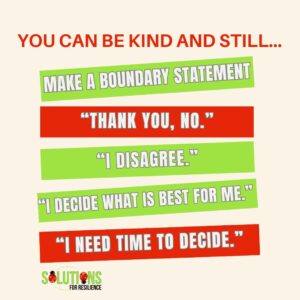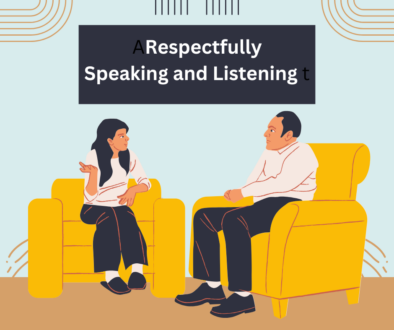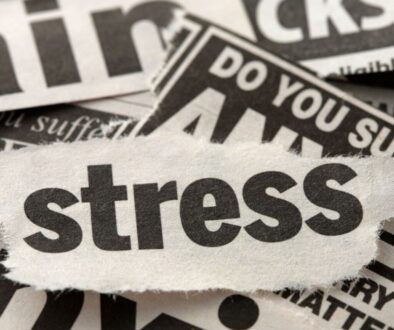Healthy Boundaries Can Protect Your Values
 Healthy Boundaries and Values
Healthy Boundaries and Values
Years ago, I learned from my friend Mabel to make this boundary statement, “It’s not good for me to say, ‘Yes’.” I had mixed feelings about having my request turned down. Her message was clear and polite. Personal and healthy boundaries provide an effective strategy to handle many relationship challenges.
As cited in my book, From woe to WOW: How Resilient Women Succeed at Work, survey respondents wrote about the power of making clear boundary statements and the consequences of not doing so. An outreach worker wrote, “I wish I’d stood up to her,” an office receptionist wrote, “I should have stood up for myself months sooner,” and a nurse wrote, “I did not make the world a better place by running away.”
In short, think of personal boundaries as similar to survey marks between neighboring properties. The marks say, “My property begins and ends here.” Some people mark their boundaries with a brick wall—hard, no entry gate and give no sense of who or what is on the other side.
Other people have boundaries similar to a decaying fence—leaving the rest of us questioning whether we are welcome to enter or not. Some people appear to have no boundaries at all until they yell at us for crossing an undefined line. Just as good fences make good neighbors, healthy boundaries make healthy relationships.
Anne Katherine wrote in Boundaries: Where You End and I Begin, “With good boundaries, we can have the wonderful assurance that comes from knowing we can and will protect ourselves from the ignorance, meanness, or thoughtlessness of others.”
Why and When to Create a Boundary
Clear and healthy boundaries help improve our communication, keep us in integrity, maintain healthy relationships and affirm our personal power for self-care. Consider the range of boundaries we consciously make or do not establish:
- Physical boundaries range from waving, shaking hands, hugging, or kissing. During COVID-19 the boundary of needing to physically distance was made clear; Six Feet! Also, during this period, domestic violence increased. Many people were not able to manage being in close proximity with one another for longer periods.
- Verbal and emotional boundaries. Words and neglect can be as harmful as physical attacks.
- Boundaries with children and family members. Family guidelines and rules help us better respect one another’s personal boundaries. One family may allow the children to come into the parents’ bedroom whenever they want. Another family may require knocking on the bedroom door.
- Intimate, sexual, dating, and marital boundaries. These range from open and flexible relationships to marriages where there is no space for affairs.
- Workplace boundaries are most often established by the leadership of the organization. For example, the boundaries around safety would be different on a construction site compared to a library.
- Ethical and professional boundaries. The era of the sleazy sales-guy is over but fraud and taking advantage of the public still happens. In my profession of therapeutic counseling, I have boundaries around confidentiality and doing no emotional harm.
- Social and cultural boundaries require us to adjust our boundary expectations. I recall when we moved from the province of Ontario to Alberta needing to adjust my driving speed to accommodate school zones. Several times when I violated the rule or boundary of a slower speed, I was royally fined.
There are other boundary categories but for now, I imagine you get the point. They protect our personal or cultural value systems.
Protect and Identify Your VALUES
On the whole, healthy boundaries help us protect our value system. Many values have to do with our personal story or history. Values are those qualities, people, behaviors and things we hold as important or worthy. We can identify our values by noting how we invest our time, money and energy.
Circle below your top five values. On what do you spend the most money, time seeking, and developing? Where do you invest your energy and focus?
acceptance * achievement * adventure * acknowledgement * animals * appreciation * art * balance * beauty * belonging * caring * challenge * change * children * comfort * compassion * competition * commitment * communication * control * cooperation * creativity * courage * dignity * discipline * diversity * economic security * education * emotional maturity * equality * enthusiasm * ethics * excellence * fame * faith * family * feelings * financial security * freedom * friendship * fun * generosity *gentleness * harmony * health * helping others * home * human rights * humor * humility * idealism * influence * integrity * intuition * joy * justice * kindness* law and order * listening * logic *loyalty * love * manners * modesty * money * music * mystery * native culture * native traditions * nature * nurturing * orderliness * passion * patience * peace * personal development * play * pleasure * power * prayer * prestige * privacy * recognition * reliability * resilience * respect * responsibility * reverence * risk taking * sacredness * seniors * sensitivity * sensuality * sex * sharing * silence * spirituality * sports and fitness * solitude * success * synergy * teamwork * tenderness * thinking * tolerance * touch * travel * truth * trustworthiness * unity * vision * winning * wisdom * Other: _________
When we clarify our values, intentions and boundaries our messages become clear and less emotionally driven. We will declare what is acceptable and unacceptable to us in a calm and non-judgmental manner. The only person over whom we have power is ourselves. To put our personal power into action we can declare what we will and will not do and then follow through. We can enforce boundaries that are important to us.
Prepare to Deliver Your Boundary Statement
Often, the mere thought of delivering our boundaries can trigger a state of anxiety within our nervous system. We may find ourselves thinking of excuses to not assert our needs.
Minaa B., a social worker, and the author of “Owning Our Struggles: A Path to Healing and Finding Community in a Broken World,” advises us to begin by asking a crucial question: “What am I going to do differently to establish a boundary for myself?”
To assist in emotional regulation and readiness to deliver our boundaries, Minaa suggests using the BEST acronym:
- B for Boundary: Spend some time identifying the specific boundary that is being crossed.
- E for Emotions: Pay attention to your body’s sensations. How does your body react as you imagine saying g your boundary? Are you feeling fear, fearing conflict, rejection, or the loss of affection? Do you feel responsible for the other person’s problems, maybe even feeling guilty?
- S for Soothe: Rather than allowing fear or other feelings to stop you, soothe those emotions. Engage in deep breathing, journaling, or recording your thoughts.
- T for Thoughts: Challenge your recorded thoughts, reframing them to imagine a potentially positive outcome.
Create a 5-Point Boundary Statement
Ensure your communication is concise and clear. Here are the five steps to create a boundary statement:
- State the value being violated. “Speaking respectfully is important to me.”
- Point out how your value is being violated. “Calling me the ‘b’ word is disrespectful.”
-
State how you feel. “I feel hurt.”
-
State what you are prepared to do. “If I am spoken to disrespectfully again, I will leave.”
-
Follow through if your boundary is violated. In the example above if disrespectful behavior continues, I will leave.
There must be consequences for those who disregard your stated boundaries. It should be an actionable response on your part. You have no control over the other. You are protecting your values and integrity with your boundary statement. It holds weight when you are committed to acting.
Additionally, here is a video that also describes the Five-Point Boundary Statement to support you to create healthy boundaries. Click Here.
Conclusion
To summarize, it is up to you to follow through on your end of the boundary declaration. As indicated in the above example, you must maintain your boundary by either staying or leaving. The more you practice creating boundary statements the easier it will become. Remember, healthy boundaries create healthy relationships and give you guidance and space to be your best! Let us know how you do. OK?
Please check out these related posts:
- What to Know about Boundaries in Relationships
- Curb the Urge to Fix People: Healing Ourselves First
- Fault Lines: Fractured Families and How to Mend Them





March 16, 2012 @ 8:55 am
Thought of you and the above topic, Establish Clear Boundaries, as I was carving away.
All the best, and thank you!
Francine
March 14, 2012 @ 2:18 pm
Pat,
Yes, I’m still in the PowerPoint business. Busy time of year, hence the delay in my response. Still many clients from Calgary. We moved to Vancouver Island 5 years ago. Will send you the link to my blog page on the “Tide Mask”, which I should finish carving sometime this week. All the best,
F
March 15, 2012 @ 10:24 pm
Good hearing from Francine,
All the best. I’ll look for your link to your blog.
February 9, 2012 @ 11:01 am
Thanks for the imagery. Did not know this encroaching phenomenon was common. Now I see it as the tide coming in with each wave, people testing how far they can push me, with each attempt. Friends and co-workers alike.
February 9, 2012 @ 2:02 pm
Hi Francine,
Thank you so much for commenting on my blog about boundaries and finding your own metaphor. I think of our national anthem, “Oh Canada! We stand on guard for thee!” But do we also do a good job of guarding our own values, ideas, physical and emotional spaces?
Do you still help people like me, in the speaking business or other businesses, design clear and beautiful slide shows?